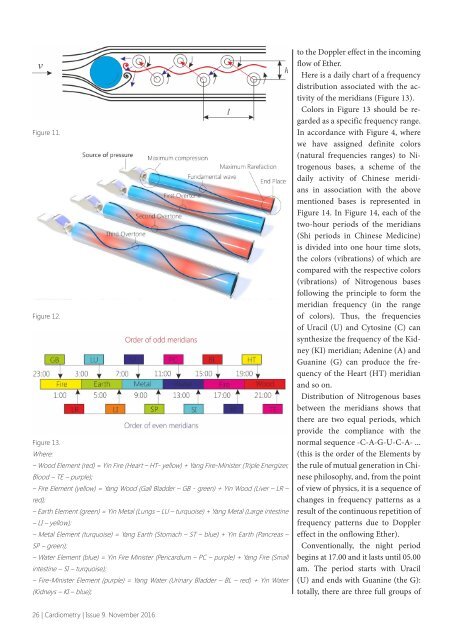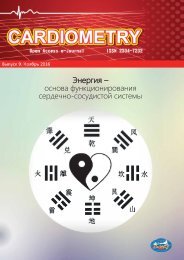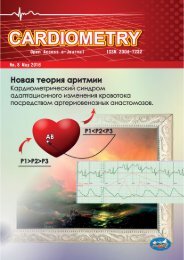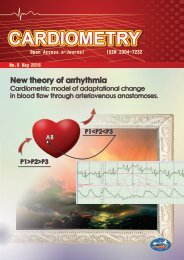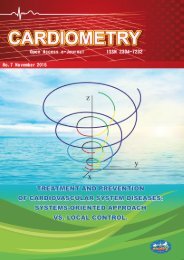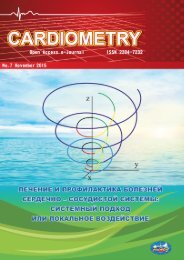Open access e-journal Cardiometry - No.9 November 2016
As might be seen, our Journal is a theme-oriented publication so that each issue offers concentrated materials targeting a certain topic. The present publication is treating the very topical problem: it is energy of the heart.
As might be seen, our Journal is a theme-oriented publication so that each issue offers concentrated materials targeting a certain topic. The present publication is treating the very topical problem: it is energy of the heart.
Create successful ePaper yourself
Turn your PDF publications into a flip-book with our unique Google optimized e-Paper software.
Figure 11.<br />
Figure 12.<br />
Figure 13.<br />
Where:<br />
– Wood Element (red) = Yin Fire (Heart – HT- yellow) + Yang Fire-Minister (Triple Energizer,<br />
Blood – TE – purple);<br />
– Fire Element (yellow) = Yang Wood (Gall Bladder – GB - green) + Yin Wood (Liver – LR –<br />
red);<br />
– Earth Element (green) = Yin Metal (Lungs – LU – turquoise) + Yang Metal (Large intestine<br />
– LI – yellow);<br />
– Metal Element (turquoise) = Yang Earth (Stomach – ST – blue) + Yin Earth (Pancreas –<br />
SP – green);<br />
– Water Element (blue) = Yin Fire Minister (Pericardium – PC – purple) + Yang Fire (Small<br />
intestine – SI – turquoise);<br />
– Fire-Minister Element (purple) = Yang Water (Urinary Bladder – BL – red) + Yin Water<br />
(Kidneys – KI – blue);<br />
to the Doppler effect in the incoming<br />
flow of Ether.<br />
Here is a daily chart of a frequency<br />
distribution associated with the activity<br />
of the meridians (Figure 13).<br />
Colors in Figure 13 should be regarded<br />
as a specific frequency range.<br />
In accordance with Figure 4, where<br />
we have assigned definite colors<br />
(natural frequencies ranges) to Nitrogenous<br />
bases, a scheme of the<br />
daily activity of Chinese meridians<br />
in association with the above<br />
mentioned bases is represented in<br />
Figure 14. In Figure 14, each of the<br />
two-hour periods of the meridians<br />
(Shi periods in Chinese Medicine)<br />
is divided into one hour time slots,<br />
the colors (vibrations) of which are<br />
compared with the respective colors<br />
(vibrations) of Nitrogenous bases<br />
following the principle to form the<br />
meridian frequency (in the range<br />
of colors). Thus, the frequencies<br />
of Uracil (U) and Cytosine (C) can<br />
synthesize the frequency of the Kidney<br />
(KI) meridian; Adenine (A) and<br />
Guanine (G) can produce the frequency<br />
of the Heart (HT) meridian<br />
and so on.<br />
Distribution of Nitrogenous bases<br />
between the meridians shows that<br />
there are two equal periods, which<br />
provide the compliance with the<br />
normal sequence -C-A-G-U-C-A- ...<br />
(this is the order of the Elements by<br />
the rule of mutual generation in Chinese<br />
philosophy, and, from the point<br />
of view of physics, it is a sequence of<br />
changes in frequency patterns as a<br />
result of the continuous repetition of<br />
frequency patterns due to Doppler<br />
effect in the onflowing Ether).<br />
Conventionally, the night period<br />
begins at 17.00 and it lasts until 05.00<br />
am. The period starts with Uracil<br />
(U) and ends with Guanine (the G):<br />
totally, there are three full groups of<br />
26 | <strong>Cardiometry</strong> | Issue 9. <strong>November</strong> <strong>2016</strong>


